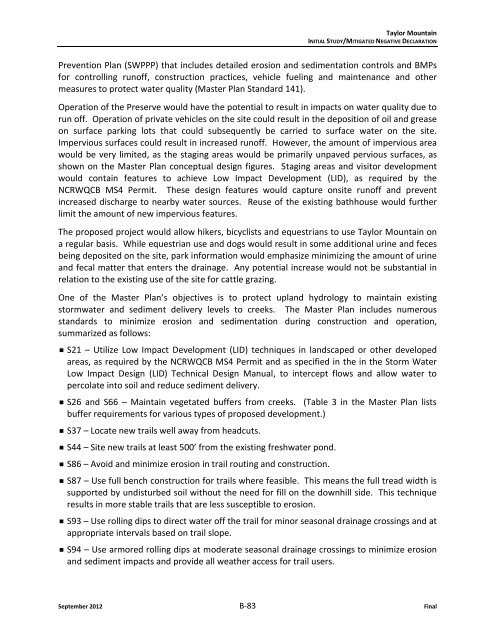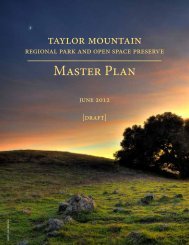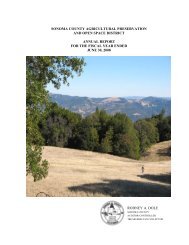Initial Study MND - Sonoma County Agricultural Preservation and ...
Initial Study MND - Sonoma County Agricultural Preservation and ...
Initial Study MND - Sonoma County Agricultural Preservation and ...
Create successful ePaper yourself
Turn your PDF publications into a flip-book with our unique Google optimized e-Paper software.
Taylor MountainINITIAL STUDY/MITIGATED NEGATIVE DECLARATIONPrevention Plan (SWPPP) that includes detailed erosion <strong>and</strong> sedimentation controls <strong>and</strong> BMPsfor controlling runoff, construction practices, vehicle fueling <strong>and</strong> maintenance <strong>and</strong> othermeasures to protect water quality (Master Plan St<strong>and</strong>ard 141).Operation of the Preserve would have the potential to result in impacts on water quality due torun off. Operation of private vehicles on the site could result in the deposition of oil <strong>and</strong> greaseon surface parking lots that could subsequently be carried to surface water on the site.Impervious surfaces could result in increased runoff. However, the amount of impervious areawould be very limited, as the staging areas would be primarily unpaved pervious surfaces, asshown on the Master Plan conceptual design figures. Staging areas <strong>and</strong> visitor developmentwould contain features to achieve Low Impact Development (LID), as required by theNCRWQCB MS4 Permit. These design features would capture onsite runoff <strong>and</strong> preventincreased discharge to nearby water sources. Reuse of the existing bathhouse would furtherlimit the amount of new impervious features.The proposed project would allow hikers, bicyclists <strong>and</strong> equestrians to use Taylor Mountain ona regular basis. While equestrian use <strong>and</strong> dogs would result in some additional urine <strong>and</strong> fecesbeing deposited on the site, park information would emphasize minimizing the amount of urine<strong>and</strong> fecal matter that enters the drainage. Any potential increase would not be substantial inrelation to the existing use of the site for cattle grazing.One of the Master Plan’s objectives is to protect upl<strong>and</strong> hydrology to maintain existingstormwater <strong>and</strong> sediment delivery levels to creeks. The Master Plan includes numerousst<strong>and</strong>ards to minimize erosion <strong>and</strong> sedimentation during construction <strong>and</strong> operation,summarized as follows: S21 – Utilize Low Impact Development (LID) techniques in l<strong>and</strong>scaped or other developedareas, as required by the NCRWQCB MS4 Permit <strong>and</strong> as specified in the in the Storm WaterLow Impact Design (LID) Technical Design Manual, to intercept flows <strong>and</strong> allow water topercolate into soil <strong>and</strong> reduce sediment delivery. S26 <strong>and</strong> S66 – Maintain vegetated buffers from creeks. (Table 3 in the Master Plan listsbuffer requirements for various types of proposed development.) S37 – Locate new trails well away from headcuts. S44 – Site new trails at least 500’ from the existing freshwater pond. S86 – Avoid <strong>and</strong> minimize erosion in trail routing <strong>and</strong> construction. S87 – Use full bench construction for trails where feasible. This means the full tread width issupported by undisturbed soil without the need for fill on the downhill side. This techniqueresults in more stable trails that are less susceptible to erosion. S93 – Use rolling dips to direct water off the trail for minor seasonal drainage crossings <strong>and</strong> atappropriate intervals based on trail slope. S94 – Use armored rolling dips at moderate seasonal drainage crossings to minimize erosion<strong>and</strong> sediment impacts <strong>and</strong> provide all weather access for trail users.September 2012 B-83 Final







